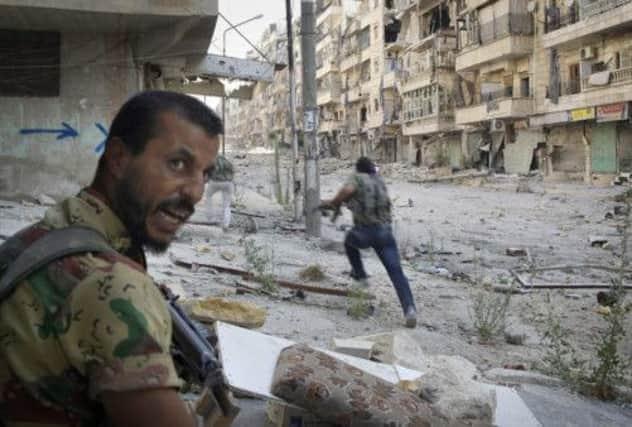Syria: Assad’s forces push to regain Homs


Mr Assad’s forces have gone on the offensive in the central Syrian city, hitting rebel-held neighbourhoods with air strikes, mortar bombs and tanks.
Forces loyal to Mr Assad have pummelled their way into the Khaldiyeh neighbourhood with constant mortar fire and tank shelling, allowing them to gain control of eastern parts of the district, said Rami Abdul-Rahman of the UK-based Observatory for Human Rights, which monitors such clashes.
Advertisement
Hide AdAdvertisement
Hide AdHe estimated government forces had seized 11 buildings in Khaldiyeh. Overall, he said the government now controls about 20 per cent of the area. “They are advancing,” he said.
He said there were street battles elsewhere in Homs, while the army continued to pound other rebel-held areas with heavy weapons.
Rebels control much of northern Syria, but have been on the back foot against Mr Assad’s army further south since it retook Qusair last month, a town near the border with Lebanon, where victory marked a change in the government’s fortunes.
Homs, 90 miles north of the capital, Damascus, lies at a strategic crossing linking the capital with army bases in coastal regions controlled by Mr Assad’s Alawite sect, an offshoot of Shiite Islam that has dominated Syria, where the majority of people are Sunni, since the 1960s.
Mr Assad is trying to cement control of this belt of territory, in a move that could drive a wedge between rebel-held areas in the north and south of the country.
In Istanbul, Ahmad Jarba, the newly elected head of the opposition Syrian National Coalition, yesterday proposed a truce for the Muslim holy month of Ramadan, which begins today, to stop fighting in Homs.
But there was no sign that the government in Damascus, with its forces now grinding out advances following setbacks earlier in the war, was ready to accept such a ceasefire.
“We are staring at a real humanitarian disaster in Homs,” said Mr Jarba, who was elected at an opposition conference on Saturday.
Advertisement
Hide AdAdvertisement
Hide AdHe said he expected advanced weapons supplied by Saudi Arabia, the main backer of the opposition, to reach rebel fighters soon and strengthen their position on the ground.
The Syrian National Coalition, a largely exile group, has little influence on rebel units in Syria. However, that could change if it succeeds in facilitating the supply of sophisticated weapons to the opposition, whose fighters say they need shoulder-launched missiles to take on Mr Assad’s air force.
“Assad, whose military machine was on the verge of defeat, has been propped up by Iran and its Hezbollah proxy,” Mr Jarba said.
Clashes and bombardment were reported by activists in nearly every Syrian province yesterday, from the outskirts of the capital in the south to the north-western farming province of Idlib to the eastern desert city of Deir al-Zor.
A local doctor working in Homs with displaced families said she had heard constant bombardment over the past few days. She said: “We’ve got so used to it we don’t even want to think about it. God protects us.”
Video uploaded by an activist group in Homs showed smoke billowing from damaged buildings and the near-constant echo of gunfire and explosions ringing through the narrow streets.
The 13th-century Khalid ibn al-Walid mosque, a prominent central landmark, could be seen in the footage. Like many of Syria’s historical treasures, the mosque, with its silver-coloured domes, has been badly damaged.
The United Nations has expressed alarm at conditions in Homs, saying last week that between 2,500 and 4,000 civilians were trapped there, suffering shortages of food, water, medicine, electricity and fuel.
Homs was the centre of protests at the start of the revolt and the armed insurgency. Many of the city’s districts have fallen in and out of government control during the past two years.